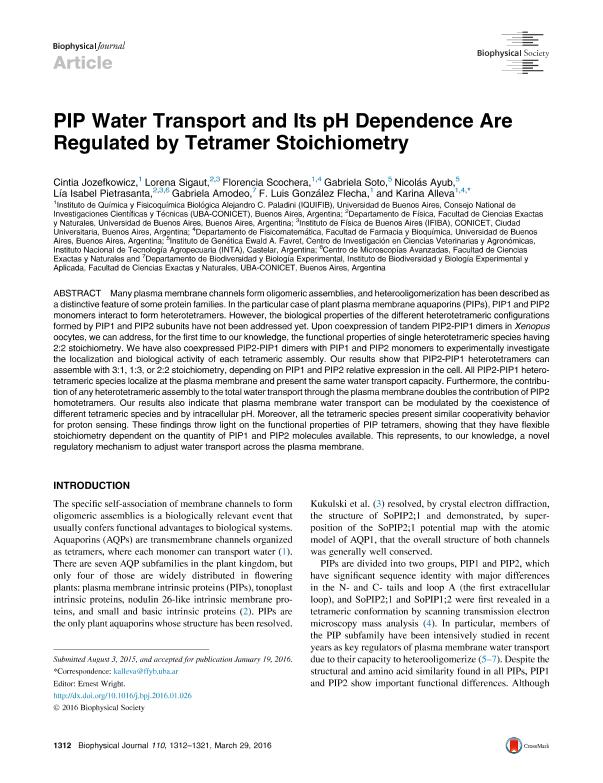Artículo
PIP Water Transport and Its pH Dependence Are Regulated by Tetramer Stoichiometry
Jozefkowicz, Cintia ; Sigaut, Lorena
; Sigaut, Lorena ; Scochera, Florencia Paola; Soto, Gabriela Cynthia
; Scochera, Florencia Paola; Soto, Gabriela Cynthia ; Ayub, Nicolás Daniel
; Ayub, Nicolás Daniel ; Pietrasanta, Lia
; Pietrasanta, Lia ; Amodeo, Gabriela
; Amodeo, Gabriela ; Gonzalez Flecha, Francisco Luis
; Gonzalez Flecha, Francisco Luis ; Alleva, Karina Edith
; Alleva, Karina Edith
 ; Sigaut, Lorena
; Sigaut, Lorena ; Scochera, Florencia Paola; Soto, Gabriela Cynthia
; Scochera, Florencia Paola; Soto, Gabriela Cynthia ; Ayub, Nicolás Daniel
; Ayub, Nicolás Daniel ; Pietrasanta, Lia
; Pietrasanta, Lia ; Amodeo, Gabriela
; Amodeo, Gabriela ; Gonzalez Flecha, Francisco Luis
; Gonzalez Flecha, Francisco Luis ; Alleva, Karina Edith
; Alleva, Karina Edith
Fecha de publicación:
03/2016
Editorial:
Cell Press
Revista:
Biophysical Journal
ISSN:
0006-3495
Idioma:
Inglés
Tipo de recurso:
Artículo publicado
Clasificación temática:
Resumen
Many plasma membrane channels form oligomeric assemblies, and heterooligomerization has been described as a distinctive feature of some protein families. In the particular case of plant plasma membrane aquaporins (PIPs), PIP1 and PIP2 monomers interact to form heterotetramers. However, the biological properties of the different heterotetrameric configurations formed by PIP1 and PIP2 subunits have not been addressed yet. Upon coexpression of tandem PIP2-PIP1 dimers in Xenopus oocytes, we can address, for the first time to our knowledge, the functional properties of single heterotetrameric species having 2:2 stoichiometry. We have also coexpressed PIP2-PIP1 dimers with PIP1 and PIP2 monomers to experimentally investigate the localization and biological activity of each tetrameric assembly. Our results show that PIP2-PIP1 heterotetramers can assemble with 3:1, 1:3, or 2:2 stoichiometry, depending on PIP1 and PIP2 relative expression in the cell. All PIP2-PIP1 heterotetrameric species localize at the plasma membrane and present the same water transport capacity. Furthermore, the contribution of any heterotetrameric assembly to the total water transport through the plasma membrane doubles the contribution of PIP2 homotetramers. Our results also indicate that plasma membrane water transport can be modulated by the coexistence of different tetrameric species and by intracellular pH. Moreover, all the tetrameric species present similar cooperativity behavior for proton sensing. These findings throw light on the functional properties of PIP tetramers, showing that they have flexible stoichiometry dependent on the quantity of PIP1 and PIP2 molecules available. This represents, to our knowledge, a novel regulatory mechanism to adjust water transport across the plasma membrane.
Palabras clave:
Aquaporins
,
Tetramer Stoichiometry
,
Ph
,
Water Transport
Archivos asociados
Licencia
Identificadores
Colecciones
Articulos(IBBEA)
Articulos de INSTITUTO DE BIODIVERSIDAD Y BIOLOGIA EXPERIMENTAL Y APLICADA
Articulos de INSTITUTO DE BIODIVERSIDAD Y BIOLOGIA EXPERIMENTAL Y APLICADA
Articulos(IFIBA)
Articulos de INST.DE FISICA DE BUENOS AIRES
Articulos de INST.DE FISICA DE BUENOS AIRES
Articulos(IQUIFIB)
Articulos de INST.DE QUIMICA Y FISICO-QUIMICA BIOLOGICAS "PROF. ALEJANDRO C. PALADINI"
Articulos de INST.DE QUIMICA Y FISICO-QUIMICA BIOLOGICAS "PROF. ALEJANDRO C. PALADINI"
Articulos(SEDE CENTRAL)
Articulos de SEDE CENTRAL
Articulos de SEDE CENTRAL
Citación
Jozefkowicz, Cintia; Sigaut, Lorena; Scochera, Florencia Paola; Soto, Gabriela Cynthia; Ayub, Nicolás Daniel; et al.; PIP Water Transport and Its pH Dependence Are Regulated by Tetramer Stoichiometry; Cell Press; Biophysical Journal; 110; 6; 3-2016; 1312-1321
Compartir
Altmétricas



